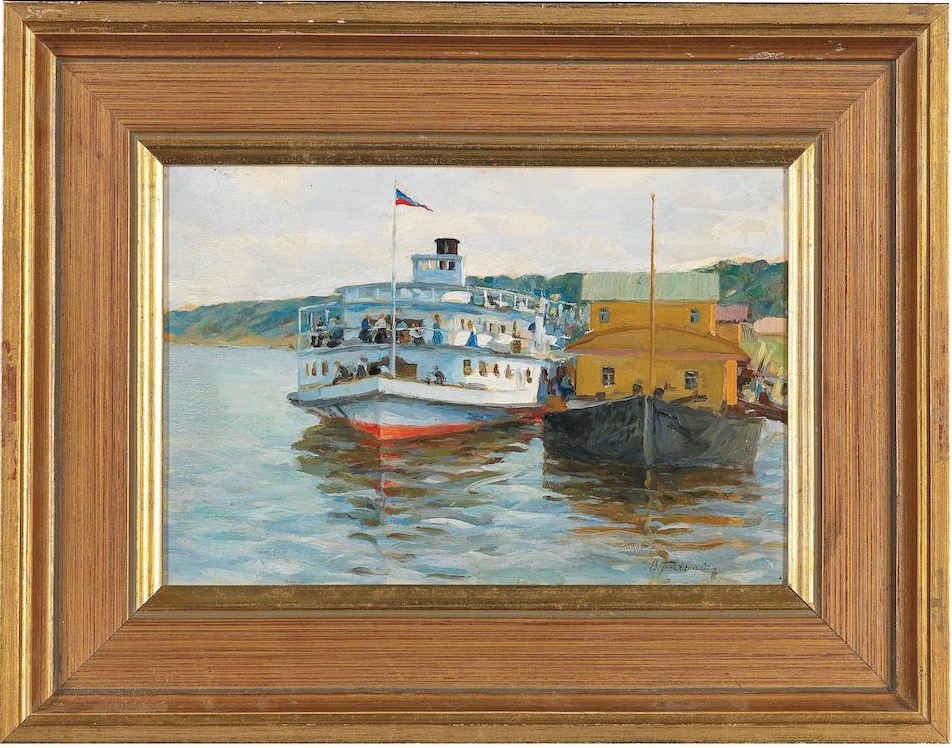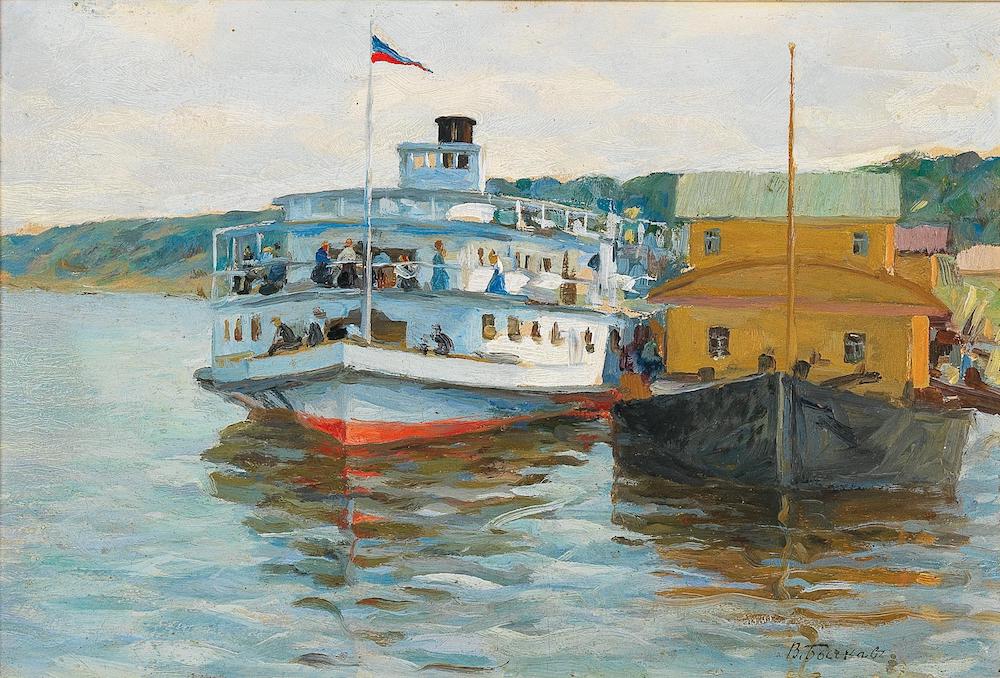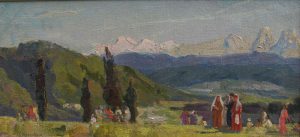Vyacheslav Pavlovich Bychkov (Russia, 1877-1954)
Russian Boat at the Volga
Material: Oil on paperboard
Dimension: 16 x 23 cm
Frame: Yes
About the Artist:
Vyacheslav Pavlovich Bychkov (28.01.1877, Yaroslavl – 4.06.1954, Moscow, buried in Vvedensky cemetery) – painter, landscape painter, genre painter.
The son of a merchant. His first skills in art he studied at a private school of artist P.A. Romanovsky in Yaroslavl. After the four-class city school in 1894, in two years he entered the Moscow School of Painting, Sculpture and Architecture. His teachers were A.M. Korin, A.E. Arkhipov, N.A. Kasatkin, L.O. Pasternak. When V.A. Serov (since 1897) and K.A. Korovin (since 1903) came to the School and renewed the whole educational process, he joined their workshops. In 1908 he was awarded a large silver medal and the title of the class artist for his picture “In the market day” (Pereslavl-Zalessky Historical and Art Museum).
Living in Moscow, Bychkov did not forget Yaroslavl. In 1902-1905 he sent his works to I – IV Yaroslavl exhibitions of pictures and art – handicraft items at city painting classes. Thus, in a review of the IV exhibition in 1905 the newspaper “Northern Edge” wrote: “Along with the masters (and participated such famous artists as Ilya Repin, VE Makovsky, AM Vasnetsov, teachers of the school Korovin, Kasatkin, Arkhipov, etc.) will go to the novice painters, former students of our city drawing classes (at the apartment Romanovsky). First of all, V. P. Bychkov: in it undoubtedly matures talent sensitive artist-colorist. Later he showed his landscapes and genres at exhibitions of the Yaroslavl Art Society (1910-1914). The newspaper “The Voice” for 1910 directly began a review of the exhibition with Bychkova: “For the first time you are ready to pass by a small picture … Boiling Volga life. A piece of this life, vibrant, fluttering grasped Mr. Bychkov. The painting has a “soul” – something that ties the colorful steamer life with the people on the dock and on deck in a single whole impression. A lot of expression. Great technique.
Further creative destiny Bychkov determined the entry into the ranks of the largest artistic association – the Union of Russian Artists. At first, he headed the Union’s organizational activities, becoming head of exhibitions in 1908 and holding this post till his last exhibition in 1923. He soon began exhibiting himself, first as an exhibitor from 1910 to 1916, then as a member from 1917 to 1923. In 1921-1922 he was elected to the committee. After the group collapsed, Bychkov, as one of its most regular participants and a follower of its creative credo, made an unsuccessful attempt to organise another exhibition in 1925. Despite the outward simplicity and modesty of Bychkov’s small paintings and sketches, he is named by researchers among the leading Union artists who determined its direction, the look of exhibitions and the circle of their participants.
In his memoirs, V. M. Lobanov presents a figure of the artist: “Bychkov was short, very active and lively, reacting keenly to all phenomena in artistic life. Since the Union of Russian Artists was set up, Bychkov has been its secretary and actually organized all its exhibitions. He collected paintings for exhibitions, was in charge of their sale, kept accounts and correspondence with members of the organization. All this did not prevent him to be a very active artist. He painted pictures devoted to the life of the Volga wharves, and every summer he lived on the Volga. His painted sketches of everyday life conveyed a variety of experiences and observations, and in the early days of the exhibition were acquired by fans of this colorful genre.
Bychkov’s work was awarded the first prize of the Moscow Society of Art Lovers in 1916 for his painting “At the Carousel” (the location is unknown). After the revolution Bychkov participated in exhibitions of the Association of Artists of Revolutionary Russia (Moscow, 1926, 1927, 1929), Society of Artists-Realists (Moscow, 1927, 1928, founding member) and others. Bychkov’s works were exhibited abroad, in New York (1924), Tokyo (1927) and Cologne (1927). Solo exhibitions were held in Moscow (1950) and Yaroslavl (1985). Bychkov was an active teacher: in a secondary school in Moscow (1902-1945) and in Moscow regional art-pedagogical school of memory of 1905 (1945-1954). Bychkov’s works can be found in museums and private collections, but most of them are concentrated in Yaroslavl Art Museum, which conducts purposeful collection and research work on the preservation of his artistic heritage.



